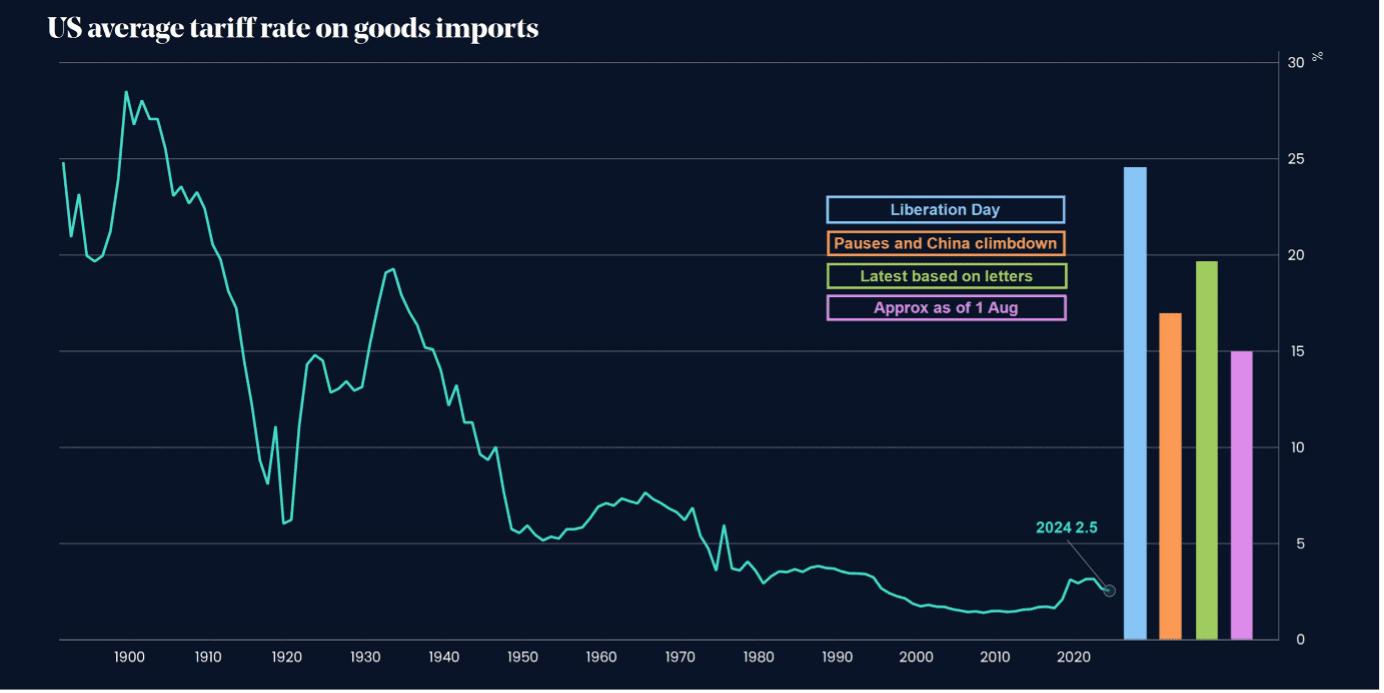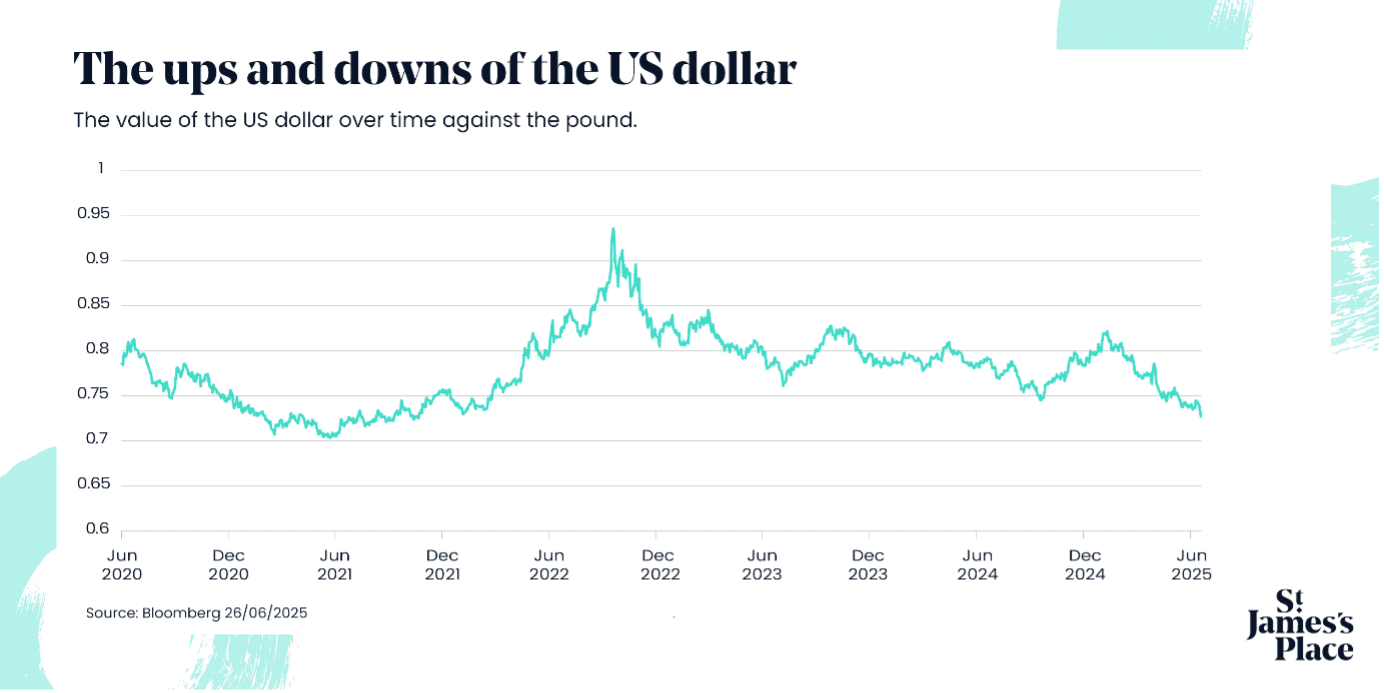WeeklyWatch – Peak season for US earnings

12th August 2025
Stock Take
US markets reach summit heights
Over the last few weeks, US second-quarter earnings have been in the spotlight, as the greatest number of companies reported in the two weeks leading up to mid-August. But with trade wars escalating, causing further volatility and uncertainty, and indications of deteriorating economic data – what are the main takeaways?
Earnings season is a key barometer of how US-listed companies – large and small – are performing, with details of their operational and financial environment, and assessment of their performance on ‘Main Street’ and in overseas markets. It’s also when companies provide guidance on prospects.
So far, approximately 80% of companies in the S&P 500 index have reported increased sales and earnings in Q2 when compared to the same period in 2024 (this is according to Factset’s financial data).
These positive earnings surprises were dominated by the strong performance of the ‘Magnificent 7’ companies, including in the communication, information technology and consumer discretionary sectors. Together, the Magnificent 7 account for over a third of the S&P 500’s total value – this is a near three-fold increase over the course of the last decade. Even though tech results were the dominant force, the financial sector has performed well and delivered strong earnings which have been boosted by the higher-for-longer interest rate environment in addition to the market volatility spurring on trading income.
A strong tech season
Sharp divergence remains in Q2 returns between the Magnificent 7 mega-cap technology companies and the remainder of the index – showcased in this week’s ‘In the Picture’. Tech-associated companies account for more than half of the US stock market’s value. The defensive sector has fallen to less than 20%.
Tech companies have outperformed due to the high demand for investing in cloud computing and AI infrastructure, as well as a resurgence in digital advertising. During the latest earnings season, these companies have been putting forward positive, upbeat outlooks. Several have opted to raise their full-year 2025 sales forecasts, which has alleviated concerns that demand for AI services is slowing down – despite the possibility that economic growth will falter. Additionally, for some, they’re projecting improvements in profit margins and indicating continuous productivity gains.
Broader market struggles to keep pace
Unlike the strong-performing tech stocks, the broader market (‘the S&P 493’) faced more of a struggle throughout Q2…
- They faced much slower consumer demand, especially for non-essential items like holidays, dining out, cars, furniture and appliances.
- With lower demand, there were higher levels of unsold goods. This could lead to discounting and more cuts in production.
- The US dollar has been weaker than other currencies since the start of 2025, leading to the increased price of raw materials.
- The volatility caused by tariffs has caused the business environment to deteriorate.
Weakened oil prices and energy sector
The weakest earnings generated during Q2 was by the energy sector. A 21% decline in oil prices in the 12 months leading up to June 2025 was the main cause of this. The materials sector, engaged in extracting and processing raw materials like iron and copper ore, was also a poor performer. As a result, more analysts are predicting that global economic growth will slow down in 2026.
Scaling the ‘wall of worry’
According to the London Stock Exchange, Q2 earnings for S&P 500 companies have grown by nearly 8% every year. Since volatility caused by the April announcement of the ‘Liberation Day’ tariffs, the index has since recovered all lost ground and is now close to its all-time high.
The Head of Discretionary Fund Management Research at St. James’s Place, Peter McLoughlin, says that investors are showing willingness to climb ‘the wall of worry’ as more positive momentum keeps building for the AI revolution and is looking to maintain a strong course. He says:
“Earnings have once again exceeded expectations – this is the third consecutive quarter of double-digit EPS growth, and current guidance suggests a high degree of resilience despite tariff concerns.”
However, he urged some caution. US government debt continues to grow at a rapid rate and currently stands at $37 trillion. McLoughlin also alludes to a deteriorating macro picture including rising unemployment and the weaker dollar value. Additionally, inflation pressures continue to mount and the trade war continues to disrupt businesses and create further margin pressures – due to the fact that not all of the extra tariff costs are currently being passed on. This was underlined further by analysts with key issues outlined by company managements being tariffs, uncertainty, inflation and recession.
Markets over the week
There was a stark recovery by the US markets from the previous week’s sell-off, as all key US indices concluded the week higher. Nasdaq led the way by closing at a record high which was boosted by Apple’s double returns. Most investors weren’t as bothered by the latest tariff announcements that took place, partly because the US administration is being more flexible on exceptions for key domestic sectors.
For Europe, major markets also ended the weak with a boost. Positive sentiment towards talks to end the war in Ukraine played a big part in this. However, despite the optimism, the FTSE 100 didn’t make much progress, even with the 0.25% interest rate cut. It’s response was likely a result of the weaker jobs market, even with the Bank of England predicting that inflation will likely rise to 4% in September: a two-year high.
Wealth Check
Investing – it’s all about doing (almost) nothing
Most investors are encouraged to go by the wise action of ‘blocking out the noise’. Situations come and go and may cause volatility as they’re seen through. Over the long-term, ignoring short-term impact and keeping your eye on your ultimate financial goals is the key to achieving what you set out to do.
However, 2025 has proven to be a challenging year (to say the least!), which has made it difficult to hold steady.
Live and unfolding
Once, international trade negotiations were found predominantly in financial outlets. Currently, it’s tariff discussions that are flooding the front pages of the newspapers and social media feeds.
As a result of the spike in inflation and rise of interest rates post-Covid, central banks have become part of the national conversation in a way that’s never been seen before. For example, when was the last time you saw a disagreement between a US president and the head of the Federal Reserve regarding interest rate changes go viral?
Another addition to the pressure is the news cycle that’s on 24 hours a day. With tech advancements, you can watch a news story break, develop and also see immediate investment reaction. Therefore, it requires a lot of effort to resist what can often feel like a bombardment of information, good or bad.
Filtering through assorted information
One of the challenging aspects to this is understanding what’s a useful insight and what’s background noise.
A key consideration for investors is to look at their investment time horizon. If it’s a long-term horizon, i.e. 10 years or more, then the majority of events won’t significantly impact your plans longer term. It’s important to remember that over the long run, companies can grow their earnings ahead of inflation, and reinvest those earnings to grow their businesses and pay dividends to their shareholders. As time goes on, the compound impact of that is what dominates returns.
The Investment Research Director at St. James’s Place, Joe Wiggins, said:
“If we look back through history, there’s been a multitude of huge events that have affected markets in the short-term. At the time, they would have seemed extremely consequential for financial markets. But as you zoom out to a longer time frame, these events usually end up looking like a blip on the horizon. So, providing you have a long-term time horizon, most things are not that consequential for meeting your objectives. The real problem is reacting to these events and making poor short-term decisions that then have a negative, long-term impact.”
The value of an investment with St. James’s Place will be directly linked to the performance of the funds selected and may fall as well as rise. You may get back less than the amount invested.
In the Picture
The chart below shows how the earnings gap between the ‘Magnificent 7’ tech companies and the broader market has grown as Q2 earnings season has unfolded.

*The Magnificent Seven is the name given to a group of seven mega-cap technology companies. These are: Apple, Amazon, Alphabet, Meta Platforms, Microsoft, Nvidia and Tesla.
** The S&P 493 refers to the S&P 500 without the Magnificent 7.
Past performance is not indicative of future performance.
The information contained is correct as at the date of the article. The information contained does not constitute investment advice and is not intended to state, indicate or imply that current or past results are indicative of future results or expectations. Where the opinions of third parties are offered, these may not necessarily reflect those of St. James’s Place.
Source: London Stock Exchange Group plc and its group undertakings (collectively, the “LSE Group”). ©LSE Group 2025. FTSE Russell is a trading name of certain of the LSE Group companies.
“FTSE Russell®” is a trademark of the relevant LSE Group companies and is used by any other LSE Group company under license. All rights in the FTSE Russell indexes or data vest in the relevant LSE Group company which owns the index or the data. Neither LSE Group nor its licensors accept any liability for any errors or omissions in the indexes or data and no party may rely on any indexes or data contained in this communication. No further distribution of data from the LSE Group is permitted without the relevant LSE Group company’s express written consent. The LSE Group does not promote, sponsor or endorse the content of this communication.
© S&P Dow Jones LLC 2025; all rights reserved.
Source: MSCI. MSCI makes no express or implied warranties or representations and shall have no liability whatsoever with respect to any MSCI data contained herein. The MSCI data may not be further redistributed or used as a basis for other indices or any securities or financial products. This report is not approved, endorsed, reviewed or produced by MSCI. None of the MSCI data is intended to constitute investment advice or a recommendation to make (or refrain from making) any kind of investment decision and may not be relied on as such.
SJP Approved 11/08/2025
WeeklyWatch – Tariffs are a go!

5th August 2025
Stock Take
It’s tariff time
Markets were pushed lower last week as the 1st August tariff deadline arrived. Several nations managed to beat the deadline and secure a deal with the US. The UK signed one much earlier, with a 10% tariff being imposed on most British exports.
A deal has also been signed between the EU and the US, where they’ll face a 15% tariff; yet this has been met with controversy across the continent and still requires signing off by several EU member states. Japan and South Korea’s agreed deals also mean that they will face a 15% tariff.
But now that the deadline has passed, there are still numerous nations that are facing more punitive measures…
- Canadian goods that aren’t covered by the US-Mexico-Canada Trade Agreement will get a 35% tariff when exporting to the US.
- Swiss imports will face a 39% tariff.
- Even though Mexico received a 90-day extension on their deadline, if no deal is agreed upon, their tariffs could reach 30%.
- Brazil originally faced a 10% tariff, but last Thursday, an extra 40% was added to many industries, including beef and coffee exports.
- China’s negotiations with the US continue – their current deadline comes up later this month.
The Chief Economist at St. James’s Place, Hetal Mehta, says that from an economic perspective, the tariffs are a “lose-lose” situation. She states:
“Ultimately US consumers will face higher prices because of them. On the exporter side, what they sell will be more expensive and therefore less competitive.”
While markets processed the situation, there was a drop in global share prices – not quite as severe as April levels, but significant all the same. The S&P 500 concluded the week at a drop of 2.36%.
Cranking up the inflationary pressure
Even before Trump was sworn in as President, many economists expressed concern towards the implementation of tariffs and the increased inflationary pressure it would put on the US and the knock-on effect that this would have on consumers.
They were shielded from much of the initial impact as a result of companies stockpiling goods before the tariffs came into effect. But these stockpiles could only last for a limited time, and in more recent months, inflationary pressures have started to weigh on the data.
The US Commerce Department’s Bureau of Economic Analysis have said that the personal consumption expenditures (PCE) price index was 2.6% for June – this is the highest number since February. Additionally, it marked a third consecutive month where the number had increased.
The PCE price index is used by the Federal Reserve (the Fed) to help inform decision-making regarding interest rates. And with continued increases in inflation, it was hardly surprising when no changes were made last Thursday.
However, there were some noteworthy moments that came from the meeting. One of these was the two dissents to the vote – they voted in favour of a 0.25% cut. This is a first since 1993 and served as an example of how challenging a position the Fed is in right now.
Comments made by Fed chair Jerome Powell following the release caught the attention of the markets. He stated:
“We have made no decisions about September. We don’t…do that in advance.”
While the Fed remains uncertain about their future stance, markets have begun to price out and plan for an interest rate drop in September when the next decision will take place.
An economic slowdown for the US?
News of the Fed’s decision not to change interest rates stayed in the spotlight for approximately a day before other economic news entered the picture.
On Friday, the most recently released payroll data suggested that the US job market was starting to soften. Only 73,000 nonfarm jobs were recorded and added to July by the Bureau of Labor Statistics. The figures for the number of jobs added in May and June are also significantly reduced, dropping in May from 125,000 to 19,000 and in June from 147,000 to 14,000.
Uneven GDP growth across the year has also contributed to the Fed’s complications in its decision-making.
On an initial look, the figures that were released in the previous week appear positive: a growth of 3% was registered over the second quarter (annualised). But, on closer inspection, there’s a different tale to tell. The growth followed a 0.5% decrease in Q1. Moreover, over the first half of 2025, US economic activity expanded only by 1.2% annualised – the first half of 2024’s increase was 2.3%.
Much of the growth in the last quarter was as a result of a drop in imports into the US. GDP growth is calculated by removing imports from the total to avoid double counting. And in Q1, the large increase of imports as a result of stockpiling consequently brought down the overall rate of GDP growth. When Q2 came round, companies were sitting on a surplus of goods – with tariffs starting to nip at the heels – and import levels decreased significantly, which boosted GDP growth into positive territory.
In her comments regarding the figures, Mehta says:
“If you strip out the trade side of it, what you see is that consumer spending has taken a step down from where it was. This also ties in with the cooling jobs market as well and interest rates staying elevated.”
Considering both the job data and the consumer spending, it suggests that the US economy is slowing down.
Wealth Check
How comfortably do you want to live in retirement?
Whether you’re planning to retire in 5 years or 20, it’s essential to have an idea of how much money you’ll require to live comfortably once your regular earning comes to an end.
The Pensions and Lifetime Savings Association (PLSA) have crunched the numbers and released new figures on how much money individuals and couples require in order to live a comfortable, moderate or minimum standard of living during their retirement.
The most important thing to bear in mind is that figures have increased over the last 12 months and will continue to do so as the cost of living continues to go up. The latest numbers were released in February this year.
- Minimum – A single person requires £13,400 a year in order to achieve the minimum living standard, which will cover most people’s basic needs. You could take a holiday in the UK, eat out around once a month and spend £450 on clothes and footwear per year. However, you can’t expect to run a car. Even with the 2025/2026 full State Pension – £11,973 per year – there’s still a shortfall.
- Moderate – This lifestyle requires £31,700 and is a more financially secure and enjoyable option. With this lifestyle, you could afford a two-week European holiday, eat out a couple of times a month and own and run a small car.
- Comfortable – £43,900 is required for this level of retirement lifestyle. You can enjoy further luxuries and higher ticket items, including regular beauty treatments, theatre trips and at least two weeks of holiday in Europe plus a couple of weekend mini breaks each year.
For couples, the price tag of these three lifestyles is £21,600, £43,900 and £60,000 per annum.1
Pension realities
There will be many who’ll be shocked to find out that their savings will provide little income and will worry that they left it too late to start saving.
If you qualify for the full annual State Pension, the PLSA says you’ll need to amass a pension pot of between £540,000 and £800,000 (for a single person) in order to achieve a comfortable retirement.2 If you want to turn your pension into an annuity, this will pay you a guaranteed annual income for life during your retirement.
By combining the full State Pension and a workplace pension, many will be able to look forward to the PLSA’s minimum level of retirement. But even with a modest contribution, it’s unlikely to cross over the line of minimum and moderate levels of living in retirement. Beginning to plan proactively at an early stage to set yourself up for your later years can literally pay dividends.
The value of an investment with St. James’s Place will be directly linked to the performance of the funds selected and may fall as well as rise. You may get back less than the amount invested.
Source:
1, 2 Retirement Living Standards, Pensions and Lifetime Savings Association, 2025. All figures quoted were developed by the Centre for Research in Social Policy at Loughborough University on behalf of the PLSA.
In the Picture
The tariffs may be lower than previously threatened in the earlier part of 2025, but following the August announcements, they’re still significantly above levels seen over the last few decades.

The information contained is correct as at the date of the article. The information contained does not constitute investment advice and is not intended to state, indicate or imply that current or past results are indicative of future results or expectations. Where the opinions of third parties are offered, these may not necessarily reflect those of St. James’s Place.
Source: London Stock Exchange Group plc and its group undertakings (collectively, the “LSE Group”). ©LSE Group 2025. FTSE Russell is a trading name of certain of the LSE Group companies.
“FTSE Russell®” is a trademark of the relevant LSE Group companies and is used by any other LSE Group company under license. All rights in the FTSE Russell indexes or data vest in the relevant LSE Group company which owns the index or the data. Neither LSE Group nor its licensors accept any liability for any errors or omissions in the indexes or data and no party may rely on any indexes or data contained in this communication. No further distribution of data from the LSE Group is permitted without the relevant LSE Group company’s express written consent. The LSE Group does not promote, sponsor or endorse the content of this communication.
© S&P Dow Jones LLC 2025; all rights reserved.
Source: MSCI. MSCI makes no express or implied warranties or representations and shall have no liability whatsoever with respect to any MSCI data contained herein. The MSCI data may not be further redistributed or used as a basis for other indices or any securities or financial products. This report is not approved, endorsed, reviewed or produced by MSCI. None of the MSCI data is intended to constitute investment advice or a recommendation to make (or refrain from making) any kind of investment decision and may not be relied on as such.
SJP Approved 04/08/2025
Business Matters – Issue 43
We hope you like the new look and format of Business Matters – please spare 1 minute to let us know what you think. Take survey >
The smart way to step away: 7 things every SME owner needs to do before exiting a business

If you’re a business owner thinking of hanging up your boots, you might be considering selling up and realising the value you’ve worked so hard to build. Perhaps you’re dreaming of sunkissed beaches or even an exciting new venture.
Whatever life after an exit holds for you, your strategy is one of the most important parts of leaving your business. But navigating the sale process can be fraught with challenges, and preparation is essential.
In our latest issue of Business Matters, Wellesley advisers Ian Howard and Samantha Kaye join forces with guest contributor Nusrat Qureishi, Head of Corporate & Commercial Law at stevensdrake solicitors, to discuss how you can ensure a smooth transition.
Exit Strategies may include the referral to a service that is separate and distinct to those offered by St. James’s Place.

Exiting on your terms
First things first! A business sale is just one way out. Understanding the variety of exit strategies available to you is essential for a smooth transition.
- Trade sale – Sell your shares or assets to another owner/company in your industry.
- Partial exit – Don’t want to give it all away just yet? Step back a bit, but still stay involved.
- Management buy-out – Let your current managers buy and run the business.
- Employee ownership trust – Sell to your team through a tax-friendly set-up.
- Don’t sell at all – Appoint a Managing Director or CEO to run the day-to-day, while you retain ownership and enjoy the dividends.
- Liquidation – If a sale doesn’t work out, a Members’ Voluntary Liquidation (MVL) might be your route.

Preparation is key
Whichever exit route you go down, preparing a company for the transition is crucial to maximising value and minimising risks that could jeopardise a successful exit.
While getting the sale over the line might seem like the most pressing concern, it’s essential to plan ahead. It can take years to prepare a business for sale but those owners that prepare well will not only optimise value but also achieve better deal structures. We recommend starting at least five years before your ideal exit date.
To help you create a timeline, we’ve put together seven ways to prepare.

- Lock in your personal and business goals
There are three basic considerations to ensure your financial future when planning an exit:
- Personal finance plans – Consider the ‘pot of money’ needed to strengthen your financial future and fund retirement.
- A business plan – Spell out how the value of the business will be built.
- How that value will be turned into cash – i.e. how and to whom the business will be sold.
Clarifying your objectives helps you define what you want from the sale (e.g. financial gain, company legacy), enabling you to structure the deal to align with those goals.
Ian says:
“By determining how much money you need for your retirement lifestyle, this will help set a target ‘exit value’ for your business – taking into account the current tax regime and prevailing financial conditions as a base case scenario. Then you can build a timeline with those key milestones of what needs to happen when, and go from there.”
Nusrat agrees:
“Having a clear idea about what your non-negotiables are means that you can quickly filter out buyers/timescales not aligned with what you’re looking for.”

- Streamline the due diligence process
Sales often stall due to missing information or unaddressed concerns. Organising your documents, contracts and financial records in advance helps prevent any delays.
Getting everything in order early doesn’t just build buyer trust, but can save you money in professional fees too. Indeed, bad housekeeping is one of the most common legal pitfalls seen during the due diligence stage, says Nusrat.
She continues:
“As solicitors ‘coming in cold’ to a deal, probably 99 times out of 100 we find an issue regarding the documents pertaining to the company. And it’s an immediate flag for us – immediate extra cost and time. Not to mention that it can scare off potential buyers.
“Statutory registers are a prime example. They’re a requirement under the Companies Act, but I often find that smaller companies don’t have them – or they’re collecting dust somewhere! The owners are so busy running the company, and don’t have the admin resources that huge corporates do. But whether it’s a sale for £50,000 or £5 million, you still have to broadly follow the same processes. The same rules are applicable.”
Nusrat also highlights missing shareholder minutes, supplier contracts, supporting documents for employees, share transfer evidence, intellectual property details or even mismatched details with Companies House as common issues.

- Attract qualified buyers
When a business has well-documented financial and operational records, it demonstrates discipline and transparency. Buyers crave this certainty, and a prepared business makes it easier to attract high-quality parties willing to pay a premium for a business primed for success.
Nusrat continues:
“Having well-prepared accounts and robust legal documentation is so much more attractive and lower risk for a potential buyer. It shows everybody in the company knows what’s going on. There are integrated systems and documented contracts – not just where something’s been done on a handshake!”
There are other things your business should be able to demonstrate if you want to achieve a good sale price. Things like having a good spread of loyal customers or long-term client relationships, a strong financial profile, evidence of good growth and future potential are factors that are likely to appeal to a potential buyer.

- Optimise tax strategies
Structuring an exit strategically can minimise tax consequences, benefiting you financially. Making full use of reliefs such as Business Asset Disposal Relief (BADR) and Business Relief can reduce the tax owed on sale. But planning shouldn’t end there, consider the income you’ll need post sale to maintain your lifestyle, and factor in current and future taxes like Income Tax, Capital Gains Tax, and Inheritance Tax. With recent Budget changes including rises in minimum wage, National Insurance, and Capital Gains Tax, many owners are reassessing their plans.
Samantha explains:
“Now more than ever, business owners need to take a proactive approach to their exit strategy. Making use of the available tax reliefs and thinking ahead to how your post-sale income will support your lifestyle, while factoring in both current and future tax liabilities, is essential. With the right advice, you can exit your business in a way that protects and enhances your financial well-being.”
Against a complicated backdrop, engaging with a financial adviser is a vital step. Understanding the full tax implications of your business exit can help you secure the best possible outcome for your future – and your family’s.
The levels and bases of taxation, and reliefs from taxation, can change at any time. The value of any tax relief depends on individual circumstances.

- Maximise business valuation
Potential buyers closely examine financials. Addressing any inefficiencies and resolving outstanding debts and clarifying asset ownership makes the business more attractive, as buyers want to invest in a company without unexpected financial burdens.
Another legal strategy business owners can implement early to maximise business value ahead of an exit is securing intellectual property, like patents, trademarks, copyrights or proprietary tech. These unique assets are tough to replicate and give buyers confidence in long-term market advantage and strong return potential.

- Ensure continuity for your team and operations
Creating guides on operations, processes, customer relationships and employee roles makes the transition smoother for the new owners and reduces disruptions. What’s more, if you own an SME and are looking to sell with a clean break, think about how closely your name, reputation and role are woven into your business.
Nusrat gives an example:
“You could be so heavily involved and don’t like to delegate. It’s a risk for buyers, as they can’t always see the processes or structures that they could seamlessly inherit because it’s so tightly wound with you and your personal branding.”
What’s more, a solid succession plan ensures that essential staff are motivated to stay through the sale, preserving the company’s value and knowledge base.
If a sale isn’t viable, you might need to look at liquidation. Scaling back or closing a business is challenging, but careful planning and consideration of the legal requirements can protect you and your employees. Ensure you understand employees’ rights in insolvency, such as around redundancy, and the Protection of Employment (TUPE) rules if selling a going concern.
Ian adds:
“Closing a business is never an easy decision, but it doesn’t have to mean chaos or uncertainty. With the right planning, you can meet your legal obligations and support your employees. Understanding your responsibilities ensures that you exit with clarity and integrity, even in difficult circumstances.”

- Take a cross-disciplinary approach
Preparing a company for sale is an investment in its future value. Using trusted advisors – financial, legal and accountancy – can not only help ensure the deal concludes successfully but it also enables you to command a higher price. It will also secure a smooth transition for you and your employees, while protecting both your interests and the business itself.
Nusrat concludes:
“Engaging a cross-disciplinary team is absolutely essential! People are often nervous about spending money because they can’t see a material value, but it’s an investment that can cut down the costs down the road. By engaging with a solicitor early, it helps address compliance issues, reducing legal risks in the transaction. Your advisers will look at the detail to the nth degree. Nothing will be left unturned.”
Samantha summarises:
“I always say that adding a good financial adviser, solicitor and accountant to your power team can bring a level of tailored specialist support you simply can’t get from anyone else in your support network. This really comes into its own during business exit planning. It’s a collaborative, long-term relationship – as financial advisers, we’re there to support you in making your own choices.”

What’s your exit strategy?
Selling your business is one of the biggest decisions you’ll ever have to make, and it’s important to plan your exit strategy carefully to gain control of your financial future. With experts at your side, you can benefit from personalised advice and support that can help you prepare for a successful exit.
Whatever life after an exit holds for you, you can look forward to the future, with Wellesley.
If anything here has struck a chord, get in touch with us today!
Contributors

Nusrat Qureishi, Associate Director, Head of Corporate and Commercial Law Department at stevensdrake solicitors
Nusrat heads up the Corporate and Commercial team at stevensdrake. She has more than 20 years’ experience, with particular expertise in the sale and purchase of businesses and companies, as well as the establishment of partnerships and other joint ventures.

Ian Howard, Chartered Financial Planner at Wellesley
Ian has been with Wellesley since 2006 and in the industry since 1990. People often ask Ian what he does; he says, simply: “I help people.” With such a myriad of choices out there, Ian always asks clients what it is they do or don’t want to do, and takes it from there.

Samantha Kaye, Chartered Financial Planner at Wellesley
Samantha joined Wellesley in 2019 having spent 20 years working in a pensions, legal and technical environment, providing detailed assistance to a variety of financial advice firms. Her passion lies in providing people with bespoke advice tailored to their individual requirements.
WeeklyWatch – Trade deals reached – more nations sign up!

29th July 2025
Stock Take
Indices vs tariffs
A new week – and more new record highs have been reached around the globe for multiple indices, as national leaders have worked hard to shelter themselves from the looming threat of the US tariffs.
Japan beats the deadline
The deadline continues to count down to 1st August when the tariffs are due to be introduced, and negotiations surrounding them have been making the headlines once again. Japan signed a trade deal on Wednesday, which includes a 15% tariff on imports from Japan – a significant improvement from the original 25% tariff that imports from Asian nations were facing. As well as a reduction in the tariff, the deal also included a $550 billion investment package from Japan into the US.
This helped boost the Nikkei, with many Japanese shares seeing a rise following the announcement. Car manufacturers Toyota and Honda were some of the biggest beneficiaries of the news, as their shares rose by around 10%.
The index was up by 4.1% by the end of the week, but it was too little too late when it came to Japan’s 20th July Upper House election. The event resulted in Prime Minister Shigeru Ishiba and his ruling coalition losing control of the Upper House and populist opposition parties making important gains. Despite the setback, Ishiba has remained resolute that he’ll remain in power as he looks ahead to overseeing the agreed Japan–US trade deal play out.
The EU also strikes a deal
As the weekend unfolded, the EU also reached a trade agreement with the US, securing a 15% tariff – half the threatened 30% if a deal wasn’t reached. Additionally, the deal will reportedly involve Europe spending hundreds of billions on US energy and arms, plus an investment of $600 billion into the US.
Even though European stocks closed before the trade deal was announced, they still managed to finish the week with a slight increase, although some automakers slumped.
Global sign-ups
Indonesia and the Philippines have also secured trade deals with the US – and at a lower rate after the deal comes into force. Overall, international markets were encouraged by the progress being made on a wider scale.
Small caps on the rise
Following the recovery from Liberation Day, news has been centred mostly on large companies, many of which are now trading at historic highs. This was illustrated by Nvidia’s recent success as it became the first company in history to achieve a market cap of $4 trillion.
However, some of the biggest winners of the year to date have been small cap companies (smaller companies) outside of the US. As a group, these companies have managed to outperform even the US large caps in the year to date.
The Equity Strategist at St. James’s Place, Carlota Estragues Lopez, said:
“International small caps have benefited from positive macroeconomic sentiment from interest rate cuts in several developed market economies, the prospect of fiscal stimulus in Germany and business reforms in Japan. Smaller companies tend to be more sensitive to interest rates and domestic economic conditions.”
An exception to this is within the US itself, where smaller companies experienced overflows when the initial tariff announcements were made and the fear of recession scared the markets. Moreover, the Federal Reserve’s hesitancy to cut interest rates in comparison to Europe has also had an impact.
With the US small caps not in favour at the moment and the large caps mostly recovered, there’s an extremely wide valuation gap between the two groups in comparison to past results. However, this could present an intriguing investment opportunity…
How is the UK faring?
It’s still good news for the FTSE 100! The index remained above the 9,000 mark as companies continued to benefit from their strong results.
The Office for National Statistics revealed on Friday that the June heatwave boosted UK retail figures by 0.9% in June – encouraging news following the 2.8% drop in May. And with a tax rise announcement in the Autumn Budget looking increasingly likely, Chancellor Rachel Reeves will breathe a small sigh of relief to see more promising activity in the UK consumer base. But it’s worth remembering that June’s 2025 figures are still down compared to pre-pandemic levels.
Are the good times here to stay?
Uncertainty still remains around Trump’s international trade policies but despite this, equities have made great progress and broken into record territory in recent weeks.
Nations that have signed deals with the US are still facing pretty hefty tariffs, giving rise to the question: why did markets drop significantly after the Liberation Day announcement, but are now seemingly able to take tariffs somewhat in their stride?
Estragues Lopez suggests:
“The back and forth has impacted policy credibility as anticipated tariffs were scaled back. The initial panic has been replaced by renewed investor optimism on hopes of trade deals being made. In addition, earnings have remained robust and even beating expectations in some sectors such as Communication Services, Technology and Financials.”
Wealth Check
Beating the 60% tax trap
The average UK salary currently stands at £37,500.1 So earning £100,000 should feel more comfortable, but it’s often not the case. Even though wages have been rising gradually, personal tax thresholds have been frozen since April 2021. Consequently, more people are reaching the higher tax band and falling into the 60% tax trap.
But wait, you might be thinking, a 60% tax band doesn’t exist. While it isn’t an official band, if your income lies between £100,000 and £125,140, the complexities of the UK tax system come into play…
What is the 60% tax trap?
Income tax is charged at 0%, 20%, 40% or 45%, depending on your income amount. Scotland rates differ slightly.
You’re entitled to a £12,750 personal allowance as a basic rate taxpayer – this is the amount of income you can receive each year without paying Income Tax. When your income is £100,000 or more, the personal allowance is reduced or tapers off.
The allowance tapers down at a rate of £1 for every £2 of income above £100,000 currently. For example, for every £100 of income between £100,000 and £125,140, the Income Tax deduction is £40 and another £20 is lost by the tapering of the personal allowance. Additionally, employee National Insurance (NI) is paid at 2% on the income – in total, this comes to a 60% tax rate, plus NI – a real double jeopardy…
When your income stands at £125,140 or more, you become an additional rate taxpayer and the allowance is lost – 45% tax is paid as a result.
Beat the tax, use your pension
Bringing your taxable income below the threshold can be achieved through putting more money into your pension before the tax year-end. Simple, quick and a win-win – you’ll reduce your tax bill and also increase your retirement fund.
For example, if you receive a £1,000 pay rise or bonus that takes your taxable income to £101,000, if you put that £1,000 straight into your pension, you’ll avoid the 60% tax zone, plus you’ll receive the benefit of a 40% top-up on your contribution as a result of pension tax relief for higher rate taxpayers.
The annual pension allowance does put a limit on these tax benefits. £60,000 is the current standard annual allowance but can be lower for higher earners. However, it’s possible to ‘carry forward’ any unused allowance from the three previous tax years. Tax relief on personal contributions is limited to a maximum of 100% of earnings in the tax year that you make the contributions.
If you find yourself just over one of the tax bands, contributing more to your pension can reduce your tax in several ways. As whatever you add to your pension reduces your taxable income and receives tax relief, we highly recommend putting in as much money as you can afford.
Are you facing a 60% tax bill, or want to find out more? Get in touch with our financial advisors today.
The value of an investment with St. James’s Place will be directly linked to the performance of the funds selected and may fall as well as rise. You may get back less than the amount invested.
The levels and bases of taxation, and reliefs from taxation, can change at any time and are generally dependent on individual circumstances.
Any tax relief over the basic rate is claimed via your annual tax return.
Source
1Statistica, average annual earnings for full time employees 2024.
In the Picture
Breaking 9,000 – the latest big accomplishment of the FTSE 100. The dot.com bubble, 2008 financial crisis and 2020 pandemic – shares have certainly taken a battering over the years. But the time gap between 8,000 and 9,000 was under 30 months… So, what’s next in store for the FTSE 100?
Past performance is not indicative of future performance.

The information contained is correct as at the date of the article. The information contained does not constitute investment advice and is not intended to state, indicate or imply that current or past results are indicative of future results or expectations. Where the opinions of third parties are offered, these may not necessarily reflect those of St. James’s Place.
Source: London Stock Exchange Group plc and its group undertakings (collectively, the “LSE Group”). ©LSE Group 2025. FTSE Russell is a trading name of certain of the LSE Group companies.
“FTSE Russell®” is a trademark of the relevant LSE Group companies and is used by any other LSE Group company under license. All rights in the FTSE Russell indexes or data vest in the relevant LSE Group company which owns the index or the data. Neither LSE Group nor its licensors accept any liability for any errors or omissions in the indexes or data and no party may rely on any indexes or data contained in this communication. No further distribution of data from the LSE Group is permitted without the relevant LSE Group company’s express written consent. The LSE Group does not promote, sponsor or endorse the content of this communication.
© S&P Dow Jones LLC 2025; all rights reserved.
Source: MSCI. MSCI makes no express or implied warranties or representations and shall have no liability whatsoever with respect to any MSCI data contained herein. The MSCI data may not be further redistributed or used as a basis for other indices or any securities or financial products. This report is not approved, endorsed, reviewed or produced by MSCI. None of the MSCI data is intended to constitute investment advice or a recommendation to make (or refrain from making) any kind of investment decision and may not be relied on as such.
SJP Approved 28/07/2025
WeeklyWatch – Market twists and turns – the ups and downs

22nd July 2025
Stock Take
Are rising markets here to stay?
The FTSE 100 broke the 9,000 barrier last week, meaning that it reached a new record high. And across the pond, US markets also enjoyed positive results despite the lows they endured in early April; investor confidence in US assets has returned.
2025 has been quite the rollercoaster ride for markets. As it stands, current trajectories are on the up, but can investors confidently put their faith in continuing highs, or is there another twist in the tracks to come?
Onwards and upwards for the UK?
To date this year, the FTSE 100 has made significant gains of more than 10%. After hitting its record high of 9,016 last Tuesday, it’s fallen back slightly to 8,986 at the time of writing.
One of the main reasons for this success is down to the companies that make up the index – including big banking names, like HSBC and Lloyds Banking Group, and the defence sector, which includes BAE Systems. Strong earnings growth across these two sectors has subsequently been a driving force in the FTSE 100’s success.
Additionally, the rally has also been boosted by mining and commodity stocks and the rallying of the price of copper. Overall, this indicates that the market is battling through the noise that’s been created by the US tariffs and has adopted a more positive approach.
One of the lesser-known factors that has also contributed to the index’s success is the companies that have launched share buyback programmes in the last few months in order to increase their values or improve their balance sheet. Since December 2024, the UK has been outpacing the US in share buybacks, as a percentage of market cap. Moreover, mergers and acquisitions are also on the rise. These combined factors are helping underpin a strong UK stock market.
Is the budget a bump in the track?
Despite the positivity, there’s a need for caution. The UK’s budget gap is becoming more of a problem – one that’s been compounded by government U-turns on welfare spending.
Recent reports revealed that the government was considering selling cryptocurrency confiscated from scam investment schemes to try and raise £5 billion for the coffers.
Regardless of whether this happens, tax rises in the Autumn Budget look pretty certain. So, are we anticipating a gloomier outlook than hoped? Tax rises will undoubtedly have some kind of impact on consumer confidence, which could even extend to investor sentiment, yet there are still strong reasons to remain positive about the UK.
One significant reason is that the UK market has been underperforming for a while, meaning that it’s less expensive compared to the US market and has better opportunities for value and growth. As mentioned above, earnings growth has shown great strength across large cap companies. Numerous experts also think the same is the case for smaller and mid-cap companies.
Investment Specialist at St. James’s Place Nina Stanojevic believes that UK equities are “increasingly catching the attention of investors”. This is down to a combination of excellent valuations, strong earnings potential and proven market resilience. She says:
“Valuations remain among the most depressed globally – both in absolute terms and relative to historical levels. This means they offer one of the most attractive valuation tailwinds in developed markets.”
Most companies within the FTSE 100 also have great exposure to international markets as 70%–75% of revenues is generated overseas. Additionally, this shows that the index is far less reliant on the domestic economy when it comes to performance and is resilient to possible downturns.
Stanojevic adds:
“The UK’s high international revenue exposure, coupled with robust dividend yields, supports not only strong global earnings growth potential but also income resilience.
“And from a portfolio perspective, UK equities also offer investors valuable diversification benefits.”
Dips and rises for the US
It would be an understatement to say that US markets have had a rollercoaster of a year. At the beginning of 2025, the S&P 500 started at around 6,000 and plunged to 19% below its peak at the start of April on the back of Trump’s Liberation Day of tariff declarations.
Since then, there has been a steady rise, with only small falls affecting the upwards trajectory. At the time of writing, the index stood at 6,296.
To showcase the extent of how up and down the US markets can be: investors withdrew more than $51 billion in assets from the US in April – the largest monthly foreign outflow from the US in five years.
Last Thursday, the US Treasury released data that revealed the direction of travel had reversed. In May, a whopping $319 billion of foreign investment went into the US – a new record by a margin of $60 billion. $146 billion of inflows was received by US treasuries and US equities benefitted by $114 billion.
Is shaky confidence in the US warranted?
Investor confidence may have rallied, but clouds still loom on the horizon– in particular, the latest global tariffs announced by Trump that are coming into place on 1st August. Many nations are scrambling to agree on deals before the deadline, but time is quickly running out.
The Equity Strategist at St. James’s Place, Carlota Estragues Lopez, says:
“While the markets may be expecting Trump to back down on tariffs in some way, there is no guarantee of this. The impact of tariffs is still very uncertain and that introduces fragility into US earnings.”
She highlights the fact that US companies citing tariffs in their Q2 earnings calls is at an all-time high. She adds:
“We need more visibility on the impact of tariffs on US company earnings to assess whether the S&P 500 rally is backed by strong fundamentals.”
Company profits could be negatively impacted by higher tariffs, which could additionally increase inflation as businesses will look to push costs on to customers.
An awkward curve in the rails
Over the course of the decade, US equities have significantly outperformed international equities – boosted by the very high relative valuations of US companies. More specifically, returns have been fuelled by the Magnificent 7 technology companies.
But the outcome has resulted in a big concentration risk. Around two-thirds of global equities now sit in the US – a huge increase over the last decade. The top 10 stocks in the US make up over a third of the US stock market, which is the highest concentration in six decades.
Lopez states that the high valuations of US companies, concentration issue and the uncertain macroeconomic backdrop makes for a risky picture for investors as they try to plan ahead:
“Given elevated starting valuations, US equities appear to offer more downside risk than upside over the medium term. We cannot foresee when the US exceptionalism narrative will peak, but it is unlikely that it will grow from its current 70% weighting to closer to 100%, or a larger dominance of global equity indices.
“In contrast, given cheap valuations in the UK, there is a lot more room for upside surprises because there are lower expectations attached.”
The Federal Open Market Committee suggest that the US will likely see economic growth of 1.4% for 2025 (compared to GDP growth of 2.8% recorded in 2024). However, US job data published earlier in the month showed better than expected numbers – 147,000 jobs were added in June.
It’s widely expected that the Federal Reserve will cut interest rates sooner than expected, which could help the S&P 500 strengthen even more before the end of the year.
While there’s no crystal ball that can tell us exactly what the future entails, such as what will happen in the ongoing Middle East conflict and subsequent geopolitical instability. Only one thing is certain, and that’s more volatility.
Wealth Check
Be the boss of your business growth
Finances and funding are essential if you want to successfully grow your business. The CEO of business growth advisory at Elephants Child, Martin Brown, addresses some of the important questions that business owners have put forward regarding this topic. (Where the opinions of third parties are offered, these may not necessarily reflect those of St. James’s Place.)
The UK economy relies on small and medium-sized enterprises (SMEs) – they represent over 99% of all businesses.1 So how do we ensure that we continue to fuel the growth of these smaller but essential businesses?
If a business wants to scale up, careful strategic investment and funding are required. Whichever funding source you choose, lenders will need to see a robust business plan in place. By having one, you’ll maximise the chance of securing the funds you need.
- How much will you need?
The amount you require will depend on your sector, goals and growth stage. A typical UK SME tends to require between £50,000 and £250,000 to fund expansion operations, invest in tech, increase staff numbers or break into new markets. High-growth start-ups in sectors like fintech or health tech will usually require more – upwards of £1 million for product development and market impact.
- Where can you find the capital?
You can seek out the more traditional options, including bank loans and government-backed schemes like the British Business Bank’s Start Up Loans or the Recovery Loan Scheme. If you’re looking to get more flexible funding, you can consider venture capital, angel investors or equity crowdfunding platforms. Additionally, asset-based lending and invoice financing can be helpful with short-term cash flow.
Personal loans, credit cards and support from family and friends are a common way for business owners to get started. If you’re a newer, fast-growing business, you may look to explore grant funding, particularly in innovation-heavy sectors. Organisations like Innovate UK offer non-dilutive grants for R&D activities. This is a kind of funding that doesn’t require the business to give up any equity or share of ownership. And accelerators and growth hubs provide region-specific support and advice.
A solid business plan, realistic financial projections and a clear growth strategy will be the best way to ensure that you secure funding. Whether you’re increasing team numbers or launching new products, having the correct funding can vastly increase your chance of success. This means aligning funding to the need and having a clear understanding of the numbers.
- Should I take out a loan, seek investors or self-fund?
How you fund your SME’s growth is a pivotal decision and is dependent on your business goals, risk tolerance and financial situation.
- Loans – These provide quick access to capital without giving up ownership. If you have a steady cash flow and want to maintain control, this is a good choice. But you must bear in mind that you’ll need to manage repayments and interest – your growth plan must therefore support future revenue.
What are they best for? Stable businesses that need capital to scale operations or assets.
- Seeking investors – Equity funding from high-net-worth individuals, angel investors, venture capitalists or crowdfunding platforms can inject significant growth capital and strategic guidance. Repaying the funds won’t be required, but you’ll give up a share of ownership and decision-making authority. High-growth, scalable businesses looking to move quickly are well-suited for this option.
What are they best for? Start-ups or SMEs in high-growth sectors like tech or biotech.
- Self-funding – This is also known as ‘bootstrapping’ and uses personal savings or reinvested profits, allowing for full control and avoiding debt or dilution. But this option limits growth speed and can pressurise your finances.
What are they best for? Early-stage businesses with modest capital needs and founders willing to take a financial risk.
No size fits all when it comes to business funding. It’s important that you consider your growth timeline, risk tolerance and control preferences. Hybrid approaches (combining self-funding with loans or investment) usually offer the best balance. Securing that first “lead’ investor is a critical moment.
An unlikely first option for raising finance is seeking funding from angel investors, venture capitalists or crowdfunding, as conditions are attached by the fund managers for any agreement that’s reached. By their nature, these will be more onerous than those imposed by a mainstream lender.
Source
1Gov.uk October 2024
In the Picture
As US equities continue to recover and even reach new record highs in recent weeks, it’s easy to assume that the usual US market dominance will return.
But you don’t have to cast your mind too far back to see that past performance isn’t the determiner of future results.
The chart below shows that in the first 10 years of the 21st Century, emerging markets were the main characters in the growth story. US equities were pretty flat over this same time period. But between 2010 and 2023, US equities really soared and significantly outperformed emerging markets.
We can’t know for certain what will happen over the next few years, especially given the current volatile geopolitical environment and economic pressure the US is facing.
Past performance is not a reliable indicator of future performance.
Please note it is not possible to invest directly into s financial index and the figures shown do not take into account any charges applicable to the appropriate investment wrapper or any relevant tax charges.
The value of an investment with St. James’s Place will be directly linked to the performance of the funds you select and the value can therefore go down as well as up. You may get back less than you invested.

The information contained is correct as at the date of the article. The information contained does not constitute investment advice and is not intended to state, indicate or imply that current or past results are indicative of future results or expectations. Where the opinions of third parties are offered, these may not necessarily reflect those of St. James’s Place.
Source: London Stock Exchange Group plc and its group undertakings (collectively, the “LSE Group”). ©LSE Group 2025. FTSE Russell is a trading name of certain of the LSE Group companies.
“FTSE Russell®” is a trademark of the relevant LSE Group companies and is used by any other LSE Group company under license. All rights in the FTSE Russell indexes or data vest in the relevant LSE Group company which owns the index or the data. Neither LSE Group nor its licensors accept any liability for any errors or omissions in the indexes or data and no party may rely on any indexes or data contained in this communication. No further distribution of data from the LSE Group is permitted without the relevant LSE Group company’s express written consent. The LSE Group does not promote, sponsor or endorse the content of this communication.
© S&P Dow Jones LLC 2025; all rights reserved.
Source: MSCI. MSCI makes no express or implied warranties or representations and shall have no liability whatsoever with respect to any MSCI data contained herein. The MSCI data may not be further redistributed or used as a basis for other indices or any securities or financial products. This report is not approved, endorsed, reviewed or produced by MSCI. None of the MSCI data is intended to constitute investment advice or a recommendation to make (or refrain from making) any kind of investment decision and may not be relied on as such.
SJP Approved 21/07/2025
WeeklyWatch – Inflation figures are hotting up

15th July 2025
Stock Take
Is inflation starting to come to the boil?
It’s been a humid couple of weeks, and inflation in the summer can be just as hot and uncomfortable. A hotter summer is often welcomed, but it can also have a marked effect on inflation. So, what’s in store this sunny season?
Tomorrow, the Office for National Statistics will reveal the latest inflation figures for June, and they’re widely expected to show a rise in inflation, following May’s inflation figures being lower than expected. There was an increase of 3.4% in consumer price inflation (measured by the Consumer Prices Index (CPI)) in the 12 months to May 2025, in comparison to the 3.5% in the 12 months to April. From now on, inflation is expected to take an upward trajectory.
What’s influencing inflation?
When the weather heats up, one of the most evident effects is on food prices, thereby pushing up inflation. Long periods of hot weather can have a significant impact on harvest yields, and reduced supplies of fruit and vegetables results in a price hike for consumers.
Hot British summers also see demand increase for items like barbecues, inflatables and, more and more, fans. This could lead to increased prices as retailers struggle to meet the demand.
But this isn’t unique to the UK. Across the globe, climate change is causing more extreme weather and heatwaves are becoming a regular occurrence. As a result, there’s increased concern regarding the impact it will have on economies in years to come.
Research conducted by the European Central Bank (ECB) discovered that not only do heatwaves push food prices up, but they also lead to reduced economic activity. A recent study revealed how the extreme heatwaves of 2022 increased food prices in Europe by 0.7 percentage points.
The ECB also implied that the hot weather results in reduced productivity and could lead to bigger economic challenges in the upcoming decades as extreme climate events become more common.
Tariffs and the inflation picture
There’s been no lull in tariff talk this week, as developments in the tariff war can also have a negative effect on inflation.
Last week, the US announced that new tariffs would come into force on 1st August. Many people thought that President Trump would adopt a lighter approach following the market tumble after the previous tariff announcement, but he wasn’t deterred. The letters that were distributed to trading partners stated hefty tariffs of 30% for the EU and Mexico. A 25% tariff has been outlined for Japan and South Korea, who are already key trading partners for the US. And Brazil was threatened with a huge 50% tariff.
Despite concerns, the market reaction so far has been relatively calm, potentially with the expectation and hope that there will be some cutback on at least some of these tariffs. US equity indices were mostly flat; the S&P 500 was down 10 basis point for the week (in dollars). For the UK, the FTSE 100 and FTSE 250 indices increased by 1.3% and 0.3% respectively.
There’s only two weeks left for nations to agree on trade deals, and they face more risks further down the road – along with US inflation. Increased US tariffs make the prices of goods from other nations higher which is likely to reduce exports which will impact growth.
The Chief Economist at St. James’s Place, Hetal Mehta, says:
“Once again there has been a scattergun approach. As well as tariffs on individual countries, there are also some sector-specific levies being threatened, such as 50% on copper and a threat that pharmaceuticals could eventually go to 200%. This potentially takes the effective average tariff rate to around 20%.
“At the beginning of the year the average tariff rate was less than 5%. It’s therefore a huge jump to go to 20% and it will be interesting to see how markets continue to react to that news.”
What’s UK economic growth looking like?
The UK is one of a few countries to have reached and signed a trade deal agreement with the US, but that doesn’t mean that we’ve become immune to the impact of the tariffs imposed elsewhere around the globe. Most UK goods exported to the US have a 10% levy attached to them which could result in higher inflation for the country. And if increased inflation passes through, this could become risky for UK economic growth.
Last week’s published figures revealed that the UK GDP fell by 0.1% in May, month on month. This came on the back of a 0.3% drop in April, contrasting the expected modest economic growth rise of 0.1%.
But Mehta dispels the gloomy outlook, saying:
“The fact that growth slowed down from what was a strong start to the year isn’t really a surprise. Given the tax increases that have kicked in and the somewhat weaker business sentiment, we should expect growth to slow down. But the good news is that credit conditions have been easing and that should temper recession risks for the UK.”
If the economy grows at a slower rate, it could help keep inflation figures down. This is because it boosts the chances of interest rates coming into place sooner rather than later.
Andrew Bailey, Governor of the Bank of England (BoE), identified that the UK economy was growing slower than expected but it gave the BoE space to cut interest rates which he thinks will be on a downward trajectory. The current BoE base rate is 4.25%, and investors will be watching closely to see what is decided when the BoE Monetary Policy Committee have their next meeting on 7th August.
How have Europe’s markets responded?
There was an advance in the equity markets, even though those gains were front loaded as the hope of an advantageous trade deal between the EU and US dwindled. There was a rise of 1.1% (in euros) in the MSCI Europe ex UK index, which was boosted by strong gains for France and Germany.
How have Asian markets fared?
The latest stage of the tariff wars was felt significantly by the Japanese markets. The Nikkei 225 fell by 0.6% (in yen). China’s Shanghai Composite added 1.1% (in yuan) encouraged by the possible additional government stimulus to combat the constant deflationary pressures in the economy.
Wealth Check
Guided to greatness
Success is reliant on the support of others, whether that’s in your life or career. This can come from members of your family, friends, trusted mentors or experts that offer insightful guidance. Earlier this year, St. James’s Place met with leading figures from across the arts and entertainment industry to understand how advice has influenced their journeys.
- Actor, producer and director David Harewood experienced a lightbulb moment when one of his teachers gave him the idea that he should pursue acting.
- TV presenter and world-champion dancer Oti Mabuse still leans on the support of two coaches that she’s known since she was a teenager.
- Actor and singer/songwriter Asha Banks holds profound gratitude for her parents’ encouragement when she starred in musicals as a child.
- Radio/TV presenter and former dancer Ashley Roberts cites an important early lesson from her ballet teacher regarding professionalism.
Here are some of the highlights they shared…
David Harewood MBE
“About five weeks before I was going to leave school, my teacher phoned and asked me to come in. He said to me: ‘What are you going to do when you leave?’ I was 15. I said, ‘I don’t know, sir.’ And he said, ‘Well, we’ve been talking in the staff room, and we think you should be an actor.’
“It was a eureka moment. I had no idea that was what I could do. There were very few Black actors when I was growing up. But it gripped me. I auditioned for the National Youth Theatre, was accepted, and when I met all these other actors, I thought, ‘That’s my tribe.”
Oti Mabuse
“We did a lot of dance camps where we’d [learn about how to take care of our] mental health. Because it’s tough to grow up in a world where you’re weighed when you do shows and your dress must look a certain way.
“It was making sure that, as teenagers, we understood that we’re going to go through this. I had two incredible coaches, Lorcia Cooper and Rafiq Hussain. Their philosophy was that everything starts from inside and will be reflected outwards.”
Asha Banks
“My parents aren’t in the industry. I just went to this audition [for Les Misérables]; my mum and my grandma came up to London with me, and I managed to get the part.
“When I look back now, it would have been impossible for me to do any of the shows that I did without my parents. They had to get on the train every day, take me up to London, then sit in a café and wait for me. As a kid, you don’t appreciate it. Now, I feel very lucky to have parents who were able to help me do that.”
Ashley Roberts
“I started dance when I was about three – a little half-tap, half-ballet class. And then it grew from there – dance became my passion and my escape. My ballet teacher said to me: ‘If you don’t show up on time, door closed: you ain’t getting in.’ That has stuck with me to this day.”
Four pieces of advice passed on:
-
David Harewood – Keep on learning: “When I got Homeland, I hadn’t worked for almost nine months. It was probably the worst time of my career. When I first arrived in America, I would go to the set, and I would sit in the corner and watch (actors) Mandy Patinkin and Claire Danes work. I learned so much in that period.”
-
Oti Mabuse – Failure is a great teacher: “We fail, but we learn. You learn so much from failing – and I’ve only learned that later in life. Now, when I fail at something, I say, ‘You know what? I had a good time, and I learned something.”
-
Asha Banks – Keep your feet on the ground: “When things are being blown out of proportion, my mum always says: ‘Life’s not over; no one’s dead.’ It’s easy to dramatise things. But remembering where we are and putting things into perspective has been really helpful.”
-
Ashley Roberts – Be open to opportunities: “I started presenting by being on the road with The Pussycat Dolls. There were fans who would stay outside, and I started interviewing them. I edited it together, and I just put it out on social media. Someone from MTV hit me up and asked if I wanted to host some shows. So, follow stuff that you love and enjoy, but also stay open and stay curious.”
Watch the conversations between David, Oti, Asha and Ashley in full here.
In the Picture
The magical Wimbledon fortnight has come to an end: the trophies have been awarded, the Pimm’s has been shelved and the strawberries and cream have been devoured. But while it may all be over for another year, the benefits of making a small annual investment – the cost of a top-of-the-range Wimbledon ticket, for example – has the potential to make many an investor feel like a champion.
If you were to invest £315 today in the stock market, and assumed an annual growth rate of 6.25%, in 50 years’ time, it could be worth nearly £15,000. But someone who invested £315 in the stock market annually could potentially get an investment worth more than £105,000 in 50 years’ time.
Investment Specialist at St. James’s Place Corinne Lord says:
“This offers a reminder of the power of compounding and the long-term potential of investing.
“Investing regularly and staying the course, despite inevitable volatility, can significantly improve financial outcomes.”
The ball’s in your court!
These figures are examples only and they are not guaranteed – they are not minimum and maximum amounts. What you get back depends on how your investment grows and the tax treatment of the investment. You could get back more or less than this.

The information contained is correct as at the date of the article. The information contained does not constitute investment advice and is not intended to state, indicate or imply that current or past results are indicative of future results or expectations. Where the opinions of third parties are offered, these may not necessarily reflect those of St. James’s Place.
Source: London Stock Exchange Group plc and its group undertakings (collectively, the “LSE Group”). ©LSE Group 2025. FTSE Russell is a trading name of certain of the LSE Group companies.
“FTSE Russell®” is a trademark of the relevant LSE Group companies and is used by any other LSE Group company under license. All rights in the FTSE Russell indexes or data vest in the relevant LSE Group company which owns the index or the data. Neither LSE Group nor its licensors accept any liability for any errors or omissions in the indexes or data and no party may rely on any indexes or data contained in this communication. No further distribution of data from the LSE Group is permitted without the relevant LSE Group company’s express written consent. The LSE Group does not promote, sponsor or endorse the content of this communication.
© S&P Dow Jones LLC 2025; all rights reserved.
Source: MSCI. MSCI makes no express or implied warranties or representations and shall have no liability whatsoever with respect to any MSCI data contained herein. The MSCI data may not be further redistributed or used as a basis for other indices or any securities or financial products. This report is not approved, endorsed, reviewed or produced by MSCI. None of the MSCI data is intended to constitute investment advice or a recommendation to make (or refrain from making) any kind of investment decision and may not be relied on as such.
SJP Approved 14/07/2025
WeeklyWatch – The clock’s ticking on the tariff pause

8th July 2025
Stock Take
Trump delays tariffs once more
The nations that haven’t yet agreed on a trade deal with the US likely had an uncomfortable start to the week, with the 90-day pause in higher tariffs on US imports originally set to end tomorrow (9th July). However, last night the President officially pushed the deadline back, sharing letters with 14 world leaders warning of levies from 1st August.
He also set out plans for a 25% tax on products entering the country from Japan and South Korea, a 40% tariff on goods from Myanmar and Laos, a 36% tariff on goods from Thailand and Cambodia, a 35% tariff on goods from Serbia and Bangladesh, a 32% tariff on Indonesia, a 30% tariff on goods from South Africa and a 25% tariff on goods from Malaysia and Tunisia. But despite the threats, he suggested he would be open to further trade talks.
Currently, the only countries that have signed a trade agreement with the US are the UK and Vietnam. And despite the challenges in their relationship, China seems to be close to agreeing on a deal. Europe, on the other hand, are seemingly nowhere near to an agreement.
We’ve become accustomed to confusion being the norm, and it’s the same scenario here. On Sunday, Trump had announced that nations would either get a letter or have agreed on a trade deal by Wednesday this week. But Trump’s announcement was then followed up by the US Commerce Secretary, Howard Lutnick, who said that the tariffs won’t come into effect until 1st August – confirmed last night.
And in another contradictory action, last weekend Trump threatened to levy a 10% tariff on any country that is aligned with the BRICS group of nations (Brazil, Russia, India, China, South Africa, plus others) on the grounds that BRICS are ‘anti-American’.
Counting the cost
It’s been estimated by the International Monetary Fund that Trump’s tariff policies could decrease global economic growth by 0.5% next year. In the short term, higher import costs could increase inflation, which will put a squeeze on US consumers. The likely impact this would have on growth will also create a negative backdrop for US treasuries.
With the tariffs not coming into effect until 1st August, the markets can feel a bit of relief. Additionally, it allows for more time for trade deals to be agreed on – or even for Trump to rescind some of his imposed tariffs.
But even as they faced further volatility, the S&P 500 and NASDAQ equity indices hit new record highs for a second week, delivering gains of 1.7% and 1.6% respectively in US dollar terms. This followed the publication of the current US job figures, which revealed that 147,000 were added in June, exceeding predictions by almost 40,000.
The apparent immunity to external chaos might make the US economy seem to be a bit like Teflon. But while US markets are showing their resilience, investors are almost certainly still feeling nervous, and this feeling is likely to continue. The Chief Investment Officer at St. James’s Place, Justin Onuekwusi, states:
“Despite the headlines, the relationship between politics and equity markets is more nuanced than often portrayed. While political events can trigger short-term market movements, it’s valuations that tend to drive performance over the long term. In this environment, staying focused on long-term goals is key.”
Labour enduring the highs and lows
Keir Starmer’s Labour Party have been in power for a whole year, and needless to say, they’ve faced some very challenging times – some in the last few weeks alone. Following rebellions from other MPs, there’s been a backdown on winter fuel payments and – more significantly – a big U-turn on welfare cuts. As a result, the likelihood of steep tax rises in the Autumn Budget has increased.
Chancellor Rachel Reeves was seen to be visibly upset in the House of Commons last week, giving rise to speculation that she was facing being sacked or considering resignation. Consequently, the value of the pound fell and costs of government borrowing significantly increased in the form of rising gilt yields. But once it was established that Reeves would be remaining as chancellor, there was a positive market reaction and bond prices rose while bond yields fell.
Fixed Income Strategist at St. James’s Place Greg Venizelos states that the rapid response of the market reaction seemed to respond out of uncertainty caused by the distress of the chancellor:
“Markets were wondering who would come next as a chancellor and that uncertainty can be unsettling. Ultimately it comes down to feedback on what government is doing. The government has been given the message that it needs to follow prudent actions, as the markets are watching.”
The Chancellor’s role is a challenging one. The job entails navigating a tough domestic backdrop as well as global volatility, such as the unexpected tariffs or economic slowdowns around the globe – all of which can influence the UK.
On a more positive note, the UK economy is likely to have grown during the second quarter despite battling significant economic pressures. There was a strong indicator of economic expansion in the June purchasing managers’ index, which showed a rise from 50.1 in May to 52 in June.
Even though increased taxes are likely on their way, the stability that comes from having a consistent government in place can help underpin the economy and, to an extent, support the value of bonds. Venizelos continues:
“On balance the factors may be pointing towards lower bond yields going forward. If the government brings in more taxes and there is an adverse impact on growth, then this could also push inflation lower. This would mean the Bank of England could have more room to cut rates, potentially bringing down the cost of government borrowing.”
And the reasons to be positive don’t end there. Onuekwusi states:
“The first year of this government has brought stability for markets and investors, underpinned by a clear, pro-growth tone and a willingness to engage with business.”
However, what unfolds over the next few months will be what really delivers the final verdict on Labour’s power reclaim for investors and businesses. He adds:
“Regulatory clarity from a growth-oriented government is essential as it gives businesses and consumers confidence and encourages long-term investing. Leveraging regulation to support better investment decisions, particularly in the UK market, could unlock capital that fuels sustainable growth. However, markets also value fiscal credibility. Any move away from fiscal rules risks unsettling bond investors, especially at a time when global debt is rising and uncertainty is weighing on bond markets. Staying the course on fiscal discipline will help reinforce market confidence.
“Investors want predictability on regulation, on tax and on the broader economic direction. Striking the right balance between reassurance and realism will be crucial. Recognising the role of the private sector in delivering growth will give the government more levers to pull. In a volatile global landscape, the UK has a real opportunity to lead by creating the certainty that investors and businesses need to plan and grow.”
Markets elsewhere
Over in Europe, there was a decrease of 0.4% for the MSCI Europe ex UK index (local currency). On our side of the Channel, the FTSE 100 added 0.3%. A small positive for consumer price inflation (CPI) in Europe may have encouraged some selling pressure while investors evaluated the future investment path for interest rates on the continent.
Across in Asia, the Nikkei 225 in Japan saw a fall of 0.9% (in yen) following a stall in US trade negotiations. China’s Shanghai Composite rose by 1.4% (local currency) with the latest round of Purchasing Manager Indices showcasing a mixed picture of the economy.
Wealth Check
The below is an edited version from St. James’s Place’s latest CIO Insight. Speak to us today to read the full version.
Red caps, price traps: the US concentration conundrum
What is happening with US politics? What will the volatility mean for investments and US holdings?
The geopolitical picture appears to change daily, much of it driven by decisions made by President Trump. Many of which he later retracts or reverses. Markets have moved up and down as announcements and then concessions are made. The breakout of the recent Iran conflict saw markets move less but they still reacted. This can all be unnerving for investors to say the least.
Red caps: Rising uncertainty and politics
Trump is nothing if not a populist. And behind many of his decisions lie the sentiment ‘Make America Great Again’. These are the words you see on many red baseball caps at Trump rallies and in media coverage, and which resonate with millions of US voters.
Take the tariffs, which have swung from one direction to another and back again. The aim of these is ostensibly to reduce any trade deficits between US and other countries. The thinking being US companies have been at a disadvantage compared to their counterparts in other part of the world, because of tariffs they face exporting goods and services. By imposing tariffs on foreign-produced imports to the US, it will make US-produced goods more attractive to US consumers – so the argument goes.
Yet while tariffs may temporarily reduce trade deficits, they also cause potential economic harm. While we don’t have unfettered confidence in anyone’s ability to make economic forecasts, The International Monetary Fund has estimated Trump’s tariffs could reduce global economic growth by 0.5% next year. Meanwhile, in the short term, the tariffs could push up costs for US consumers too, causing inflation to rise.
The value of an investment with St. James’s Place will be directly linked to the performance of the funds selected and may fall as well as rise. You may get back less than the amount invested.
With Trump’s 90-day pause on reciprocal tariffs due to end imminently (9th July), it looks highly likely that more volatility lies ahead. While the UK has secured some deals, it remains to be seen whether Europe will reach a beneficial trade deal with the US. All is still to play for where China is concerned too.
Meanwhile tensions remain high in the Middle East, despite a fragile ceasefire between Israel and Iran (at the time of writing). The Russian president has also taken advantage of the geopolitical focus being elsewhere to intensify attacks on Ukraine, with that war still very much ongoing.
Despite this gloomy backdrop, the latest US consumer sentiment figures show people are feeling slightly more positive about the economy. According to the University of Michigan’s consumer sentiment index published in June, Americans’ view of the economy has improved for the first time in six months.
Yet that is in the US. For the rest of the world, US policy is still raising questions – and uncertainty – for investors, as I see all too clearly when meeting with clients. What’s next? That’s the hard part. What will lead the markets up – or down – amid such unpredictability? And where does that leave us as investors?
The value of an investment with St. James’s Place will be directly linked to the performance of the funds selected and may fall as well as rise. You may get back less than the amount invested.
The information contained is correct as at the date of the article. The information contained does not constitute investment advice and is not intended to state, indicate or imply that current or past results are indicative of future results or expectations. Where the opinions of third parties are offered, these may not necessarily reflect those of St. James’s Place.
Source: London Stock Exchange Group plc and its group undertakings (collectively, the “LSE Group”). ©LSE Group 2025. FTSE Russell is a trading name of certain of the LSE Group companies.
“FTSE Russell®” is a trademark of the relevant LSE Group companies and is used by any other LSE Group company under license. All rights in the FTSE Russell indexes or data vest in the relevant LSE Group company which owns the index or the data. Neither LSE Group nor its licensors accept any liability for any errors or omissions in the indexes or data and no party may rely on any indexes or data contained in this communication. No further distribution of data from the LSE Group is permitted without the relevant LSE Group company’s express written consent. The LSE Group does not promote, sponsor or endorse the content of this communication.
© S&P Dow Jones LLC 2025; all rights reserved.
Source: MSCI. MSCI makes no express or implied warranties or representations and shall have no liability whatsoever with respect to any MSCI data contained herein. The MSCI data may not be further redistributed or used as a basis for other indices or any securities or financial products. This report is not approved, endorsed, reviewed or produced by MSCI. None of the MSCI data is intended to constitute investment advice or a recommendation to make (or refrain from making) any kind of investment decision and may not be relied on as such.
SJP Approved 07/07/2025
WeeklyWatch – Is it Europe’s time to shine?

1st July 2025
Stock Take
From the US to Europe
Financial news has been heavily focused on US equities as of late, but in the background, European equities have been performing impressively and are making their way into the spotlight. As a result, the question arises: is it time for investors to turn their attention to our neighbours?
The MSCI ex UK has risen by 7.90% in the year to date, while the S&P 500 only increased by 1% during this same time frame. The US’s underperformance has been intensified by far-reaching geopolitical volatility and the instability caused by President Trump’s tariff vacillations, and as a result, investors have moved away from US equities, or decreased holdings, instead turning their eyes to European stock markets.
However, these are not the only factors that are influencing investors’ decisions. In the fourth quarter of 2024, European companies posted strong corporate earnings. Additionally, the yield on European equities is higher than on US equities: 3.1% compared to the S&P 500’s 1.4%.
Back in March, the creation of a €500 billion (£420 billion) defence and infrastructure fund was approved by German politicians. And at the start of June, NATO leaders agreed that by 2035, defence spending was to increase to 5% of the country’s economic output – reinforcing the strength of the defence sector if met.
It comes as little surprise that industrials (defence) is a key sector that’s driving the positive returns on European equities. There has also been strong performance from financials (banks), communication services (telcos) and utilities and construction materials (e.g. cement).
Another attraction – valuations and returns
European equities continue to impress investors and surpass US equities through their average valuations, which are significantly lower than those of the US.
The Head of Equities at St. James’s Place, James Courtman, highlights that at the start of 2025, European equities were trading at their largest valuation discount to the US in at least 20 years. Even with the recent outperformance, they remain at a large discount, although in absolute terms, they’re not extremely cheap.
Courtman adds:
“Lower starting valuations tend to correlate with high future returns. Significantly lower valuations in Europe suggest the market is already pricing in a less positive outlook for European equities.
“Another way to think about this is that European markets are more ‘fragile’ to incrementally positive developments. In contrast, US markets are pricing in less risk/more positive future expectations to a much greater extent and are thus more fragile to incrementally less positive developments.”
It’s always challenging to know which is the right or wrong approach – and to what extent – so the value of diversification for investors remains key.
He says:
“It makes sense for investors to have exposure to European equities as part of a diversified portfolio. We have a positive asset allocation view on European equities within the equity component of our multi asset funds and many of our active managers are finding attractive investment opportunities in Europe.”
Which is best? A US or European approach?
Negative sentiment towards the US in recent months has benefited European equities. Investor surveys have revealed a shift away from the US and more of a focus on other international markets, including Europe.
Even though European equities have started 2025 strongly, it’s still too soon to disregard the US market. Longer term, European equities have underperformed US equities – and by quite a large margin. US markets are traditionally prominent, driven by strong US exceptionalism that’s largely led by the size and returns of the Magnificent Seven dominating the market.
Even though there’s been strong investor enthusiasm for European equities lately, Courtman cautions:
“It usually takes a material and prolonged reversal of performance for investor behaviour to change meaningfully, in terms of shifting their portfolio exposures.”
Last week alone demonstrates the importance of ‘shutting out the noise’: US markets reached record highs and another 3.4% was added to the S&P 500, hitting 6,173.07 on Friday – its first new record high since the middle of February. In addition, the NASDAQ reached new record levels following progressive trade talks between the US and China. There was also a de-escalation of tensions in the Middle East.
Europe avoiding tariff turmoil?
Another factor to keep in mind is that the EU haven’t signed any major trade deals with the US. But given the unpredictability of the ongoing tariffs, Courtman emphasises “tuning out from the noise”.
He states:
“There is always a geopolitical or macroeconomic issue grabbing headlines – it is by and large impossible to predict how it will evolve, what the implications will be and how markets will react given their complex adaptive nature. Over the long term it tends not to be as important as it seems in the moment.”
Markets further afield and at home
It was a strong bounce back for Japanese markets, with the Nikkei 225 increasing by 4.6% (in yen terms) – the index’s technology stocks were among the best performers.
In China, the Shanghai Composite went up by 1.9% (local currency) as result of the positive trade actions with the US.
And finally, in the UK, equities had a quieter time with the FTSE 100 ending the week only 0.3% higher.
Wealth Check
A year of uncertainty
We’re only halfway through the year, and it’s already been an eventful one! From tumultuous US tariffs and the Middle East nearing the brink of war, the world’s events have been unpredictable to say the least.
Investment markets don’t respond well to uncertainty, and there’s been quite the escalation of instability in equity markets in 2025.
As an investor, what should I do?
The Head of Research at St. James’s Place, Joe Wiggins, says:
“The chances of people making really bad decisions in these types of environments is high.”
During times of geopolitical risk, when uncertainty is running high, the following key questions serve as a reminder to avoid an emotional response:
- Are you confident in predicting the result of the current situation?
- Can the financial market implications be predicted from the result?
- Will any financial market impacts be material over long-term investing?
- Are portfolios diversified enough to accommodate a range of different results?
- Have investment objectives had to change because of the uncertainty?
Easier said than done, we know. It’s highly challenging to know how and when geopolitical tensions will resolve. The need to remain humble about our investment edge is key. It can’t be found in trying to guess the actions of numerous parties in a complicated geopolitical situation.
No one can be certain in their predictions. In similar fashion, the financial markets reactions are incredibly hard to determine. Macroeconomic or idiosyncratic factors could influence market movements across different asset classes.
Additionally, it’s worth remembering that the investment horizon is long term in nature, and the market impacts that happen during this time are unlikely to be material. History repeatedly shows us that these kinds of events usually carry a short-term influence.
The current high levels of political uncertainty concerning trade, tariffs and fiscal policy underscore the importance of diversifying portfolios to reinforce resilience. This should remain a focus point, and it aligns with our long-term investment horizon – our investment objectives are unchanged.
Wiggins adds:
“The temptation to try and predict outcomes or to overstate the importance of what’s happening from a financial market is high at times like this. Instead, this is a time to have cool heads.”
The value of an investment with St. James’s Place will be directly linked to the performance of the funds you select and the value can therefore go down as well as up. You may get back less than you invested.
In the Picture
The dollar has hit a three-year low – what impact does this have on you?
In the first six months of 2025, there’s been unpredictable policy changes, economic nerves and tariff debates – all of which have resulted in the pushing down of the dollar to levels last seen in 2022.
If America is part of your upcoming travel plans, you may find that your money will go further than you were anticipating, and imports from the US will be cheaper. As for the US, items made outside the country will be more expensive; however, export prices may be more attractive.

The information contained is correct as at the date of the article. The information contained does not constitute investment advice and is not intended to state, indicate or imply that current or past results are indicative of future results or expectations. Where the opinions of third parties are offered, these may not necessarily reflect those of St. James’s Place.
Source: London Stock Exchange Group plc and its group undertakings (collectively, the “LSE Group”). ©LSE Group 2025. FTSE Russell is a trading name of certain of the LSE Group companies.
“FTSE Russell®” is a trademark of the relevant LSE Group companies and is used by any other LSE Group company under license. All rights in the FTSE Russell indexes or data vest in the relevant LSE Group company which owns the index or the data. Neither LSE Group nor its licensors accept any liability for any errors or omissions in the indexes or data and no party may rely on any indexes or data contained in this communication. No further distribution of data from the LSE Group is permitted without the relevant LSE Group company’s express written consent. The LSE Group does not promote, sponsor or endorse the content of this communication.
© S&P Dow Jones LLC 2025; all rights reserved.
Source: MSCI. MSCI makes no express or implied warranties or representations and shall have no liability whatsoever with respect to any MSCI data contained herein. The MSCI data may not be further redistributed or used as a basis for other indices or any securities or financial products. This report is not approved, endorsed, reviewed or produced by MSCI. None of the MSCI data is intended to constitute investment advice or a recommendation to make (or refrain from making) any kind of investment decision and may not be relied on as such.
SJP Approved 30/06/2025
Business Matters – Issue 42
We hope you like the new look and format of Business Matters – please spare 1 minute to let us know what you think. Take survey >
What’s your Plan B? Debunking 5 reasons why people don’t take out income protection

We can all see the logic of protection. We insure our cars, the contents of our homes and even our holidays and our pets almost as a matter of course. But have you considered protecting your most valuable asset: your income – and, by extension, your family’s quality of life?
Many financial advisers like to talk about the positive stuff with business owners – like extracting profit from your business, creating a solid exit plan and plotting how you’re going to enjoy that hard-earned retirement. But what happens if something happens before that end point?
While it’s uncomfortable to think about your business plans being derailed by illness – or worse – it’s vital to protect yourself, your business partners and your family from the unexpected. At Wellesley, we help our clients navigate these conversations, tackling those ‘What if…?’ questions proactively.

Mythbusting income protection
Only 6.2% of the working population have income protection.1 Here, we examine the biggest misconceptions that can put people off taking out income protection – and why they shouldn’t stand in your way. We also break down the key considerations for business owners and sole traders.
- “I don’t need income protection.”
If you value it, protect it.
It’s easy to be optimistic about your health and live by the mantra ‘it won’t happen to me’. But most people who find themselves unable to work due to illness or injury likely assumed it wouldn’t happen to them either.
Some avoid income protection because they believe the application and claims process is complex. Others assume their savings are the only safety net they need. But for business owners especially, personal and company finances are often intertwined.
Taking out income protection insurance might therefore stop you from having to dip into as much of your savings, so you protect your future financial well-being too. It could even mean that your emergency cash fund does not need to be quite as big but having one is still essential. These policies do not start to pay out straight away and you may also incur other unexpected expenses. You could choose to invest that money instead in your pension or into a Junior ISA for the children.
- “Insurance is too expensive.”
You can’t put a price on peace of mind. Allocating a portion of your financial plan to protection is therefore both smart and strategic.
Working out a budget to incorporate the premiums will help protect you and your family in case something happens in between now and exit/retirement.
That said, one element of the above myth is true – critical illness cover has become more expensive. As an alternative, consider income protection, which offers a similar outcome in a different manner: it doesn’t provide a lump sum but instead delivers ongoing income to help maintain financial commitments, including debt repayments.
- “I’m self-employed – I can’t get income protection.”
There are over 4 million self-employed people in the UK – none of whom receive employer sick pay or statutory sick pay.²
Being self employed doesn’t prevent you from taking out income protection – and it should be considered a crucial safety net. It can cover your personal income and ensure your fixed business expenses – such as rent, utilities and vehicle leases – are still paid if you’re unable to work. It safeguards both your lifestyle and your business continuity.
- “It won’t pay out.”
Scepticism around insurance is common, but the facts speak for themselves.
Between 2019 and 2023, major insurance provider Aviva paid out £5.37 billion in individual protection claims.3 Remember, income protection is regulated by the Financial Conduct Authority and the Prudential Regulation Authority, which exist to ensure products work in consumers’ best interests.
- “It doesn’t cover pre-existing health conditions.”
Having a medical history doesn’t automatically exclude you from income protection. While cover may vary, many providers will offer policies with exclusions or adjusted premiums.
A good adviser will help you find the right provider – one that balances your needs, health profile and budget.

Protection considerations for limited company owners
Now we’ve debunked some common myths, let’s look at insurance options we often discuss with our clients.
There are a number of policies available to cover every kind of personal circumstance – and we’ve previously discussed shareholder protection, keyperson insurance, business wills and talking to your employees about protection. But have you considered Relevant Life Plans or Executive Income Protection?
Relevant Life Plan (RLP)
Ever had “death in service” benefits as part of a corporate package? An RLP offers similar protection, but for directors or key staff within a limited company – with significant tax advantages. Think of it like a mini death in service plan.
A RLP is a life assurance plan. The limited company takes out a policy on the individual that is then placed into a master discretionary trust for the individual’s chosen beneficiaries. These are extremely tax effective as they count as a business expense (rather than a personal cost), thus reducing Corporation Tax. It’s prudent to cover an amount that includes a pay-out to cover costs like clearing your mortgage upon death.
Contributions are not treated as a benefit in kind (P11D benefit) on the employee.
Executive income protection
Unlike individual income protection, this is where a limited company sets up executive income protection for an individual/individuals.
The advantage is that it takes out the cover and insures the individual or owner/director for their income (can be both PAYE + dividends), employer National Insurance contributions and pension contributions. For limited companies, it transforms a personal expense into a business deduction – a smart, tax-efficient move for owner-directors.

Protection considerations for sole traders
Sole traders don’t have the same business structure advantages – but they do have essential options.
Life cover
This is usually associated with covering a mortgage liability and can be on a decreasing, level or increasing benefit for a fixed term. They can be used to provide lump-sum death benefits for families or to cover Inheritance Tax liabilities in the shorter term.
Income protection
Pays a percentage of your income so you can continue to cover bills and outgoings if you’re unable to work or lose an income unexpectedly. You can choose the level and term of cover to suit you and your budget.
Critical illness cover
Pays out a lump sum if you suffer a specified illness such as a stroke, cancer or an event such as a heart attack.
Family income benefit
Pays income on death or terminal illness diagnosis to cover families on the death of a parent. It’s helpful for childcare costs or maintaining household expenses.

Protecting your future, as well as your present
No one can predict the future. But you can prepare for it.
Whether you’re a sole trader or managing a growing business, protection provides peace of mind. It ensures that your income, family and long-term plans are safeguarded – even in worst-case scenarios.
Your individual circumstances will always dictate what kind of protection is most suited to you and your business. That’s where professional financial advice comes into its own – so you can be sure you have the right insurance for your needs, helping to ensure a brighter and more secure future.
So, what’s your Plan B?
Protection plans do not acquire a cash value. The cover provided will cease if premiums are stopped.
The value of an investment with St. James’s Place will be directly linked to the performance of the funds selected and may fall as well as rise. You may get back less than the amount invested.
The levels and bases of taxation, and reliefs from taxation, can change at any time and are generally dependent on individual circumstances.
Protection plans do not acquire a cash value. The cover provided will cease if premiums are stopped.
Trusts are not regulated by the Financial Conduct Authority.
Please note that advice with regard to exit strategy planning may involve the referral to a service that is separate and distinct to those offered by St. James’s Place.
SJP Approved XX/XX/XXXX
Sources:
1Financial Conduct Authority Financial Lives Survey (2024).
2Ipse, the self-employed landscape in 2023, accessed April 2024.
3Individual Protection Claims Report 2023, Aviva, May 2023 (Based on 50,600 claims).
WeeklyWatch – Markets march on despite Middle East flare-up

24th June 2025
Stock Take
US enters the Iran–Israel fray
Tension in the Middle East continues to ramp up. Despite his two-week deadline rhetoric, it took just two days for President Trump to push the button on a bombing campaign across three nuclear sites in Iran. Unsurprisingly, oil prices spiked as a result, although the market reactions have been muted (so far). But what does US involvement in Iran mean for investors going forward?
Oil, inflation and GDP
After a turbulent few days, the escalation of geopolitical hostilities is raising many questions. The movement of oil prices continues to be a key issue. In the past two weeks, the price has soared by around 20%. Since the Middle East conflict started, the price of a barrel of Brent crude oil has jumped from the mid to low US$60s to over US$81, before settling at around US$78 on Monday.
St. James’s Place’s Chief Economist, Hetal Mehta, says:
“While this increase brings oil prices back to where they were last summer, the sharpness of the move is the key concern, as well as what lies ahead.
“There are various estimates of what the oil price increase does to GDP and inflation. From a US perspective, if this price level is maintained for several weeks, it could add 0.4% to 0–5% on CPI inflation. That is notable in the current context of the US Federal Reserve trying to bring down inflation and amid tariff uncertainty.”
However, at the time of writing, the announcement of a ceasefire between Israel and Iran has resulted in an immediate drop in oil prices.
Looking at the implications for the UK, Mehta points out that even though the weekend surge in the price of oil only moved up to levels seen earlier in the year, “it’s the change that matters – particularly for the UK”. She explains:
“There are different views on this, but generally you’re looking at a drop of a couple of tenths of GDP for a 10% increase in oil prices. No one knows what’s going to happen in the current situation, but when you get these flare-ups, it’s not uncommon for the oil price to go up 50–100%. If the oil price went up 100%, then you can probably take around 2% off UK GDP growth, which would put it firmly into recession territory.”
Dire straights
As well as the oil market being in turmoil, there’s also the possibility of disruption to global supply if Iran retaliates by blocking the Strait of Hormuz. This vital shipping route supports around one-fifth of the world’s oil shipments. If it were to be closed, it could have a huge potential economic impact.
Mehta says the situation in the Strait of Hormuz is a key current consideration for markets and economists. The US has reportedly asked China to put pressure on Iran to avoid any move to close the waterway, but the situation is still uncertain.
Looking ahead
Despite the worrying escalation in the Middle East conflict and fears of what is to come, so far the impact has been “relatively contained”, says Mehta. She continues:
“When you look at the markets, they have been relatively calm following the news of the US bombing of Iran. For example, there has been little reaction from gilt markets. This suggests markets are waiting to see what happens next. There is an upside risk to inflation from the situation and there are potential stresses on the horizon. However, it is too soon to predict economic outcomes with any real certainty.”
The Chief Investment Officer at St. James’s Place, Justin Onuekwusi, agrees:
“We are paying attention and are reassured by our existing stance on resilience across our portfolios. There are macro clouds on the horizon. The price of oil, the impact the Middle East turmoil may have on inflation, stagflation and global trade are areas of concern we are watching. But for now, it’s important not to react and to focus on the long-term. We continue to emphasise portfolio resilience.”
Robin Ellis, Director of Portfolio Management at St. James’s Place, says:
“Our portfolio construction process is built upon a principle of diversification across asset class, geography, sector and region. Through our research, we look to build further resilience, which means broadening the environments within which the portfolios can perform; our aim is to perform well in environments we think are likely, but avoid performing poorly in environments we deem less likely.”
Market snapshot
The FTSE 100 shed -0.9%, while the FTSE 250 dipped just -0.1%. The pound’s recent strength has weighed down the former – given that the bulk of FTSE 100 earnings are generated overseas – but supported the latter, given the domestic-orientated natures of the companies listed on the index.
Across Europe, the MSCI Europe ex-UK index fell by -1.6% in local currency. In Asia, returns were mixed. Japan’s Nikkei 225 rose +1.5%, while China’s Shanghai Composite dropped -0.5% (both in local currency). Chinese stocks faced pressure following weaker industrial output last month, although recent retail activity showed signs of improvement.
The UK outlook
The Bank of England held interest rates steady last week, as did the Fed. However, the developments in the Middle East add new uncertainty for investors. Rising energy costs tend to push up UK inflation relatively quickly – so policymakers will be closely monitoring oil prices.
The latest data from the Office for National Statistics (ONS) showed the UK inflation rate at 3.4% in May, the same rate as April. Within that, services inflation – previously a persistent pressure point – eased to 4.7%, down from 5.4%. However, inflation in food, non-alcoholic drinks, furniture and household goods edged higher.
Retail sales were weaker, falling 2.7% in May, with food shops being particularly hard hit. According to the ONS:
“The fall was mainly because of reduced sales volumes in supermarkets, with retailer comments talking of inflation and customer cutbacks, alongside reduced sales of alcohol and tobacco products.”
On a similar note, data company GfK found consumer confidence improved slightly in May. But this survey predated the latest geopolitical flare-up, which could affect sentiment moving forward. Confidence also remains significantly lower than during the same period a year ago.
Wealth Check
Greater volatility, greater opportunities?
An increasingly uncertain world, geopolitical tension and one of the most influential powers led by a president who seems determined to be unpredictable – it’s a recipe for market volatility.
Howard Marks, co-founder and co-chair of one of St. James’s Place’s specialist external fund managers, Oaktree Capital, discusses this unusually high uncertainty and the implications of markets responding to this.
Looking back at tariff turbulence
Despite the recent escalation, the global uncertainty didn’t start in the summer. Market shifts around the US tariff announcements have dominated the headlines (and WeeklyWatch!) over the past five months.
Following the so-called Liberation Day announcements, Marks shared a note with his own investors highlighting the impact of the tariffs, saying:
“All norms have been overthrown. The way world trade has operated for the last 80 years may be of little relevance to the future. The impact on economies and the world at large is entirely unpredictable. We’re faced with large-scale decisions, yet again there are no facts or prior experiences on which to base those decisions.”
Finding value amid uncertainty
Despite this backdrop, Marks remains optimistic about the value bonds have for investors – particularly sub-investment grade corporate bonds. He acknowledges the risk of defaults (companies not paying back their debt) has increased – particularly in an environment of rising interest rates, which make it difficult to repay loans during tough economic times. However, he believes the yields now available compensate for that risk. He said in a recent conversation with St. James’s Place CIO, Justin Onuekwusi:
“If you can get annual returns of around 6–8% a year in today’s market, with the kind of uncertainty we face, that’s great.”
He reminds investors that the core appeal of bonds lies in their predictability – hence the term ‘fixed income’. You know exactly the return you’ll get (yield) if they keep their promise to pay back your money at a specified date. Companies with debt rated as sub-investment grade (i.e. high yield, meaning they are rated as riskier than others regarding defaulting) pay even more as an incentive. And even though the promise of a high-yield company is less ironclad, the returns they offer in exchange for that uncertainty remain attractive.
Perspective and patience
Describing risk tolerance as “how much volatility can you stomach”, Marks says investors should tune out the daily noise that often drives markets. Describing his own investment philosophy, he says he tries to think about what the right thing is today for a future he can’t see.
“Yesterday’s solution may not be the same as tomorrow. My job is to position capital to benefit from future events and yet we can’t predict the future.”
Some of the strongest emotions felt by investors are envy and FOMO (fear of missing out), Marks points out in an interview with St. James’s Place’s Director of Portfolio Management, Robin Ellis:
“How can you be a good investor if you let those feelings control your decision-making? The most important thing is not to get it right but to be steady and stay with it – it’s not about timing the market but time in the market that makes the difference.”
Marks concludes on the point that while investors are looking at returns over shorter and shorter time frames, it’s still the long term that matters most.
The value of an investment with St. James’s Place will be directly linked to the performance of the funds selected and may fall as well as rise. You may get back less than the amount invested.
An investment in equities and shares will not provide the security of capital associated with a deposit account with a bank or building society.
The information contained is correct as at the date of the article. The information contained does not constitute investment advice and is not intended to state, indicate or imply that current or past results are indicative of future results or expectations. Where the opinions of third parties are offered, these may not necessarily reflect those of St. James’s Place.
Source: London Stock Exchange Group plc and its group undertakings (collectively, the “LSE Group”). ©LSE Group 2025. FTSE Russell is a trading name of certain of the LSE Group companies.
“FTSE Russell®” is a trademark of the relevant LSE Group companies and is used by any other LSE Group company under license. All rights in the FTSE Russell indexes or data vest in the relevant LSE Group company which owns the index or the data. Neither LSE Group nor its licensors accept any liability for any errors or omissions in the indexes or data and no party may rely on any indexes or data contained in this communication. No further distribution of data from the LSE Group is permitted without the relevant LSE Group company’s express written consent. The LSE Group does not promote, sponsor or endorse the content of this communication.
© S&P Dow Jones LLC 2025; all rights reserved.
Source: MSCI. MSCI makes no express or implied warranties or representations and shall have no liability whatsoever with respect to any MSCI data contained herein. The MSCI data may not be further redistributed or used as a basis for other indices or any securities or financial products. This report is not approved, endorsed, reviewed or produced by MSCI. None of the MSCI data is intended to constitute investment advice or a recommendation to make (or refrain from making) any kind of investment decision and may not be relied on as such.
SJP Approved 16/06/2025